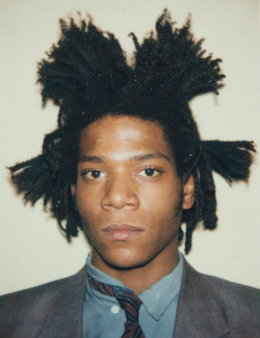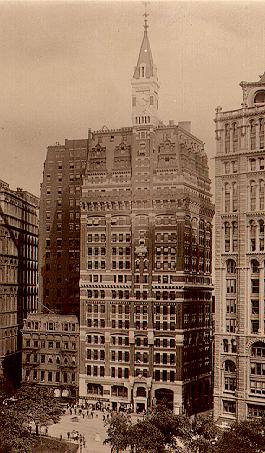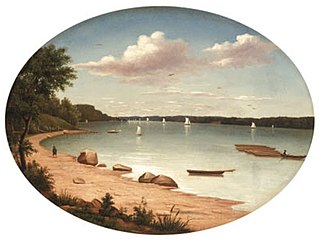
Jean-Michel Basquiat was an American artist who rose to success during the 1980s as part of the Neo-expressionism movement.

Albert Kahn was an American industrial architect who designed industrial plant complexes such as the Ford River Rouge automobile complex. He designed the construction of Detroit skyscrapers and office buildings as well as mansions in the city suburbs. He led an organization of hundreds of architect associates and in 1937, designed 19% of all architect-designed industrial factories in the United States. Under a unique contract in 1929, Kahn established a design and training office in Moscow, sending twenty-five staff there to train Soviet architects and engineers, and to design hundreds of industrial buildings under their first five-year plan. They trained more than 4,000 architects and engineers using Kahn's concepts. In 1943, the Franklin Institute posthumously awarded Kahn the Frank P. Brown Medal.

Sotheby's is a British-founded multinational corporation with headquarters in New York City. It is one of the world's largest brokers of fine and decorative art, jewellery, and collectibles. It has 80 locations in 40 countries, and maintains a significant presence in the UK.

40 Wall Street is a 927-foot-tall (283 m) neo-Gothic skyscraper on Wall Street between Nassau and William streets in the Financial District of Manhattan in New York City, New York, U.S. Erected in 1929–1930 as the headquarters of the Manhattan Company, the building was designed by H. Craig Severance with Yasuo Matsui and Shreve & Lamb. The building is a New York City designated landmark and is listed on the National Register of Historic Places (NRHP); it is also a contributing property to the Wall Street Historic District, an NRHP district.

1 Wall Street is a mostly residential skyscraper in the Financial District of Lower Manhattan, New York City, on the eastern side of Broadway between Wall Street and Exchange Place. 1 Wall Street, designed in the Art Deco style, is 654 feet (199 m) tall and consists of two sections. The original 50-story building was designed by Ralph Thomas Walker of the firm Voorhees, Gmelin and Walker and constructed between 1929 and 1931, while a 36-story annex to the south was designed by successor firm Voorhees, Walker Smith Smith & Haines and built between 1963 and 1965.

Alfred Corning Clark I was an American philanthropist and patron of the arts.

Bonwit Teller & Co. was an American luxury department store in New York City, New York, founded by Paul Bonwit in 1895 at Sixth Avenue and 18th Street, and later a chain of department stores.
The Daimler Manufacturing Company (DMFG), was a boutique American automaker company from 1898 to 1907. From 1888 to 1898, the company was known as the Daimler Motor Company (DMC), formed under a partnership between Gottlieb Daimler of Daimler-Motoren-Gesellschaft and William Steinway of piano manufacturer Steinway & Sons. Headquartered in Long Island City, Queens, New York City near Steinway's Astoria headquarters, the company sold Daimler motors for yachts and launches, and goods vehicles including buses and trucks. It built and sold a single automobile model, the original American Mercedes.

Sohmer & Co. was a piano manufacturing company founded in New York City in 1872. Sohmer & Co. marketed the first modern baby grand piano, and also manufactured pianos with aliquot stringing and bridge agraffes, as well as Cecilian "all-inside" player pianos and Welte-Mignon-Licensee reproducing pianos. Sohmer pianos were owned by U.S. President Calvin Coolidge, and composers Victor Herbert and Irving Berlin. Sohmer is now a line of pianos manufactured by Samick Music Corporation in Korea.

48 Wall Street, formerly the Bank of New York & Trust Company Building, is a 32-story, 512-foot-tall (156 m) skyscraper on the corner of Wall Street and William Street in the Financial District of Lower Manhattan in New York City. Built in 1927–1929 in the Neo-Georgian and Colonial Revival styles, it was designed by Benjamin Wistar Morris.

The Alwyn Court, also known as The Alwyn, is an apartment building at 180 West 58th Street, at the southeast corner with Seventh Avenue, in the Midtown Manhattan neighborhood of New York City. The Alwyn Court was built between 1907 and 1909 and was designed by Harde & Short in the French Renaissance style. It is one of several luxury developments constructed along Seventh Avenue during the late 19th and early 20th century.
Thor Equities is a real estate development, leasing and management firm, with headquarters in New York City, London and Mexico City. Thor Equities owns property in the United States, Canada, Europe, Russia, India and Latin America, including London's historic Burlington Arcade and the Palmer House Hilton. In New York City, Thor owns retail, office and residential properties on Fifth Avenue and Madison Avenue as well as in SoHo, Flatiron, the Meatpacking District, and Brooklyn including Coney Island. Thor also has investments in major U.S. cities including San Francisco's Union Square; Georgetown in Washington, D.C.; Robertson Boulevard in West Hollywood; Collins Avenue; Lincoln Road; Wynwood and the Design District in Miami. Thor offers investment vehicles for institutional investors through its Thor Urban Property Funds. Thor Equities also has several subsidiary companies including retail advisory and tenant representation firm Thor Retail Advisors.

Industry City is a historic intermodal shipping, warehousing, and manufacturing complex on the Upper New York Bay waterfront in the Sunset Park neighborhood of Brooklyn, New York City. The northern portion, commonly called "Industry City" on its own, hosts commercial light manufacturing tenants across 6,000,000 square feet (560,000 m2) of space between 32nd and 41st Streets, and is operated by a private consortium. The southern portion, known as "Bush Terminal", is located between 40th and 51st Streets and is operated by the New York City Economic Development Corporation (NYCEDC) as a garment manufacturing complex.

William Howard Hoople was an American businessman and religious figure. He was a prominent leader of the American Holiness movement; the co-founder of the Association of Pentecostal Churches of America, one of the antecedent groups that merged to create the Church of the Nazarene; rescue mission organizer; an ordained minister in the Church of the Nazarene, and first superintendent of the New York District of the Church of the Nazarene; YMCA worker; baritone gospel singer; successful businessman and investor; and inventor.

The City Investing Building, also known as the Broadway–Cortlandt Building and the Benenson Building, was an office building and early skyscraper in Manhattan, New York. Serving as the headquarters of the City Investing Company, it was on Cortlandt Street between Church Street and Broadway in the Financial District of Lower Manhattan. The building was designed by Francis Kimball and constructed by the Hedden Construction Company.

The New York Tribune Building was a building in the Financial District of Manhattan in New York City, across from City Hall and the Civic Center. It was at the intersection of Nassau and Spruce Streets, at 154 Printing House Square. Part of Lower Manhattan's former "Newspaper Row", it was the headquarters of the New-York Tribune from 1875 to 1923.

Robert G. L. Leonori was an American artist. Born in New York, he was a member of the American Art-Union and associated with the Hudson River School of landscape painters.

The Eberhard Faber Pencil Factory is a former pencil factory complex in Greenpoint, Brooklyn, New York City. Designated as a historic district by the New York City Landmarks Preservation Commission (NYCLPC) in 2007, it is composed of nine buildings spread across two blocks.

The Art Collection of Marshall Owen Roberts was a collection of sculptures, antiques and paintings owned by New York industrialist Marshall Owen Roberts. The collection, which featured many prominent American artists and works, including Emanuel Leutze's Washington Crossing the Delaware, remained intact following his 1880 death until it was auctioned off in 1897.

The Coignet Stone Company Building is a historical structure in the Gowanus neighborhood of Brooklyn in New York City, at the intersection of Third Street and Third Avenue. Designed by architects William Field and Son and constructed between 1872 and 1873, it is the city's oldest remaining concrete building. The Coignet Building is the last remaining structure of a five-acre concrete factory complex built for the Coignet Agglomerate Company along the Gowanus Canal.





















